Conversion of mosques into non-Islamic places of worship
The conversion of mosques into non-Islamic places of worship has occurred for centuries. The most prominent examples of such took place after and during the Reconquista.[1]
Conversion of mosques into churches
This table lists former mosques with identified original buildings or ruins. It also includes those churches where the original structure of the mosque no longer survives and the church was built at the site of a former mosque.
| Current Name | Mosque Name | Images | City | Country | Year Opened | Year Closed | Notes | Ref. |
|---|---|---|---|---|---|---|---|---|
| Mosque–Cathedral of Córdoba | Great Mosque of Córdoba (Qurṭuba), Aljama Mosque | .jpg)  |
Córdoba | Spain | early 8th century | 1236 | After Muslim conquest of the Visigothic Kingdom (710~), the site of former main Visigothic church of Cordoba was divided and shared between Muslims and Christians for seven decades. Later, Abd al-Rahman I purchased Christian part and built the great mosque in 785.[2] Major extensions were added in 9th and 10th centuries, until final extension by in 10th century under Almanzor. After Christians captured Cordoba in 1236, King Ferdinand III of Castile converted the mosque into a cathedral. Later, a cathedral was built at the center of the old mosque, configuring the current Mosque-Cathedral of Cordoba. It was the second largest mosque in the world after Mecca Great mosque from the around 9th century, until Sultan Ahmed Mosque, Istanbul was built in 1588. It had a surface area of 23,400 square metres (2.34 ha) and accommodated an estimated 32,000 to 40,000 worshipers. Current mosque structure date from 784 to 987.[3] | [3][4] |
| Mosque of Cristo de la Luz | Mezquita Bab-al-Mardum | 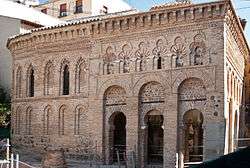 |
Toledo | Spain | 999 | 1186 | Converted into a church. One of the best preserved Moorish mosques in Spain.[3] | [3][4] |
| Giralda | Great Mosque of Seville | 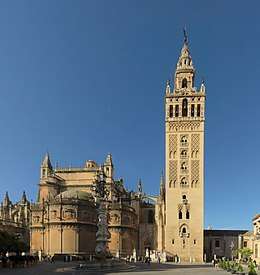 |
Seville | Spain | 1248 | Only minaret remains. Mosque comparable in size to Great mosque of Cordoba, destroyed by earthquake in 1365. Minaret used as a church bell tower was built higher in 16th century. | [3] | |
| Mezquita de Almonaster la Real |  |
Almonaster la Real | Spain | 10th century | Built on site of 5th century Visigoth basilica. Converted into a Church after Reconquista. National Monument since 1931. | [3][4] | ||
| Mezquita del Alcázar de Jerez la Frontera | .jpg) |
Jerez de la Frontera (Jerez) | Spain | 11th century | mid 13th century | Located within former Moorish fortress of Alcazar of Jerez de la Frontera. Only surviving mosque building of 18 former mosques in the Jerez city. Converted into church after Reconquista. | [3][4] | |
| Mosque of las Tornerías | Al-Mustimim | .jpg) |
Toledo | Spain | 1060[5] | Unusual two-storied mosque. Was built in a busy commercial neighborhood (Arrabal de Francos). Used as a church until 1498-1505, and other uses since. Restoration and preservation done recently. | [4][5][6] | |
| Mezquita de Tórtoles |  |
Tarazona | Spain | 15th century | Mosque remains almost not altered in the later centuries. Current building was built in 2 stages, one early 15th century, other late 15th century. It is attached to the remains of the old fortified tower of town castle. Converted into a church in 1526. | [7] | ||
| Aljama Mosque of Medina Azahara | Aljama Masjid of Madinat al-Zahra |  |
Córdoba | Spain | 940 | 1010 | A mosque in Madinat al-Zahra, a vast, fortified Moorish palace-city built by Abd-ar-Rahman III (912–961). The marbled, jeweled complex was plundered & destroyed first by Muslims, then by Christians when civil war ended Caliphate of Córdoba. A UNESCO World Heritage site since 2018. | [8] |
| San Sebastián de Toledo | Al-Dabbagin Masjid | _(cropped)_iglesia_de_San_Sebasti%C3%A1n.jpg) |
Toledo | Spain | 1085~ | Converted into a church after 1085 Christian conquest of area. Renovated several times but original interior structure remains. Building now used as a concert & exhibition hall. Bell tower built in 15th century shows characteristics of former minaret. Ruins of Arab Baths of Tenerías remain lower below on slope.[9] A short reference to mosque exist by Ibn Baskuwal (1101–83) reported by Fath ibn Ibrahim.[10] | [9][10] | |
| Small Royal mosque inside Aljafería Palace | 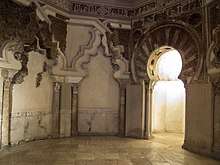 |
Zaragoza | Spain | 10th century | Located inside the great fortified palace. A small octagonal mosque, designed as a private oratory for the king and his family. Mosque architecture inspired by Córdoba mosque. Aljafería is a UNESCO World Heritage site since 1986.[11] | [11] | ||
| Mezquita-Iglesia de El Salvador, Toledo |  |
Toledo | Spain | 9th century | 1085 | Mosque built on former Visigoth or Roman substrate. Now a rebuilt church but excavations revealed 9th century structures & elements of mosque - horseshoe arch arcade, primitive stone minaret, flooring, courtyard with cistern.[12][13] | [12][13] | |
| Alminar de Árchez, Alminar Mudéjar (Mudejar Minaret of Árchez) | Masyid al-Ta`ibin, Mezquita de los Conversos[14] (Mosque of convert) | 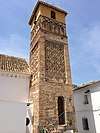 |
Árchez | Spain | 14th century | Only 15 meter tall minaret remains, used as belfry of Árchez church built on mosque location. Minaret is an Almohade architecture monument and only remaining jewel of Nazarí period.[15] | [15] | |
| San Sebastian Minaret (Alminar De San Sebastian) | 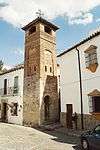 |
Ronda | Spain | 1485 | Only minaret of the medium-size mosque in Plaza Abul Beka neighborhood remains. Minaret was expanded and used as a bell tower. The mosque was converted to a church but destroyed in 1600s during Morisco Revolts. Ronda was a Muslim city for 700 years. The city had 7 or 8 mosques, none survive today.[16] | [16] | ||
| Alminar de San Juan (Minaret of San Juan) | .jpg) |
Córdoba | Spain | 930 | Only minaret remains of mosque built in 930 during 1st Spanish Umayyad caliph 'Abd al-Rahman III. Now its belfry of San Juan church.[17] | [17] | ||
| Iglesia de Santiago del Arrabal, Toledo |  |
Toledo | Spain | Converted to church in 1223-25. Caliphate era minaret survives. Church is a Mudéjar style masterpiece, built in 1245-47 on prior structures of a mosque and Visigoth building.[18] | [18] | |||
| Church of Nuestra Señora de la Encarnación (Benaque, Macharaviaya) | 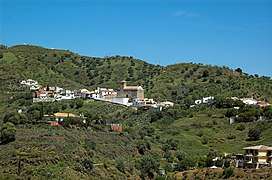 |
Macharaviaya | Spain | One of few preserved mosques with original minaret and solid block building built of brick & masonry. Interior single rectangular prayer hall now a church nave. Drilling Mecca facing wall in 2003 showed original mosque construction and 19th century work. Reconquesta era document says "...While it was the visitation and reformation of the houses in the alcayua (or alamiya) in Benaque, the inhabitants used mosque as a parish church, where they had images and heard Mass..." .[19][20] | [19] | |||
Conversion of mosques into temples
This table lists former mosques with identified original buildings that have been converted into Hindu Temples.
| Current Name | Mosque Name | Images | City | Country | Notes |
| Ram Janmabhoomi Temple | Babri Masjid |  |
Ayodhya | India | The 16th century mosque, built under the reign of and named after Mughal Emperor Babur was demolished in 1992 by a mob of Hindu nationalists. It was built in 1528 by Mir Baqi, allegedly[21] after destroying a pre-existing religious structure that may have been a temple. In 2019, after a verdict by the Supreme Court of India, the decision to construct a temple at the site of the demolished mosque was accepted by the Indian parliament. |
Conversion of mosques into gurdwaras
This table lists former mosques with identified original buildings that have been converted into Sikh gurdwaras.
| Current Name | Mosque Name | City | Country | Notes |
| Jama Masjid of Meham | Meham | India | One inscription inside the structure dates it to 1531 A.D.[22] | |
| Gurdwara Shaheed Bhai Taru Singh | Shaheed Ganj Mosque | Lahore | Pakistan | Commissioned during the reign of Mughal Emperor Shah Jahan and construction completed in 1722. Converted to Gurudwara in 1762.[23] |
| Gol Gurudwara | Gol Masjid | Amritsar | India | Reference[24] |
| Khail Bazaar Jama Masjid | Amritsar | India | Reference[24] | |
| Gurudwara Sahib | Purani Masjid | Gidranwali, Haryana | India | Reference[24] |
References
- "5 Most Impressive Historic Mosques in Spain - History Lists". historylists.org. Retrieved 2020-05-09.
- L. M. (February 27, 2014), La basílica de San Vicente Mártir, la primacía de lo cristiano, ABC
- "5 Most Impressive Historic Mosques in Spain". historylists.org. Retrieved 27 September 2018.
- "Magnificent Mosques of Spain". halaltrip.com. Retrieved 27 September 2018.
- "Las Tornerías". archnet.org. Retrieved 27 September 2018.
- "Fusion of Roman, Visigoth and Muslim culture". turismocastillalamancha.es. Retrieved 27 September 2018.
- "Mosque of Tórtoles (Tarazona, ZARAGOZA)". patrimonioculturaldearagon.es. Retrieved 28 September 2018.
- "Cordoba City - Madinat al-Zahra". andalucia.com. Retrieved 28 September 2018.
- "Church (old mosque) of San Sebastián de Toledo". arteguias.com. Retrieved 28 September 2018.
- The existence of the Al-Dabbagin mosque is attested by a short reference by Ibn Baskuwal (1101-83) reported by Fath ibn Ibrahim. see: ''Actas de las i jornadas de Cultura Islámica, Toledo'', Instituto Occidental de Cultura Islámica (ed.) 1987, p. 158
- "Aljafería Palace (Islamic part) in Discover Islamic Art". discoverislamicart.org. Retrieved 28 September 2018.
- "Iglesia de El Salvador de Toledo". turismocastillalamancha.es. Retrieved 28 September 2018.
- "Church of the Savior". toledomonumental.com. Archived from the original on 25 August 2018. Retrieved 28 September 2018.
- "San Juan de los Reyes (Granada) Alminar". wikipedia.org. Retrieved 28 September 2018.
- "Mudejar Minaret". malaga.es. Retrieved 29 September 2018.
- "San Sebastian Minaret". rondatoday.com. Retrieved 28 September 2018.
- "Minaret of San Juan". archnet.org. Retrieved 28 September 2018.
- "Church of Santiago del Arrabal". discoverislamicart.org. Retrieved 28 September 2018.
- "Parish Church of Nuestra Señora de la Encarnación Benaque". andaluciarustica.com. 16 September 2013. Retrieved 30 September 2018.
- "Church of Our Lady of the Incarnation. Mural paintings, minaret and cemetery. - Benaque (Macharaviaya)". viajerosencortomalaga.com. Archived from the original on 16 January 2019. Retrieved 30 September 2018.
- Daniyal, Shoaib (2019-11-11). "No, the Supreme Court did not uphold the claim that Babri Masjid was built by demolishing a temple". scroll.in.
The judgment notes that the temple identified by the ASI dates back to the 12th century – about four centuries before the first Mughal emperor Babur came to India from Central Asia. “No evidence is available to explain what transpired in the course of the intervening period of nearly four centuries,” writes the Supreme Court.
- "Jama Masjid, Rohtak". www.nativeplanet.com. Retrieved 2020-05-09.
- Hilal Ahmed (2015). Muslim Political Discourse in Postcolonial India: Monuments, Memory. Routledge. p. 344. ISBN 9781317559542.
- "Mosques that converted into Gurdwaras – A lesser known part of history". Muslim Mirror. 31 May 2020.
This article is issued from Wikipedia. The text is licensed under Creative Commons - Attribution - Sharealike. Additional terms may apply for the media files.